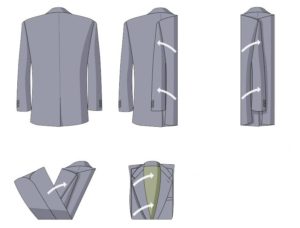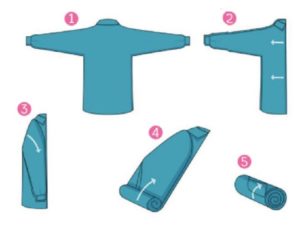When packing things into a suitcase, it is not always possible to maintain their impeccable appearance. Every now and then a couple of sweaters or blouses will fit. And folding a jacket so that you don’t have to iron it again is even more difficult. Moreover, there are many folding methods, but not everyone has the same effectiveness.
Folding methods
In theory, there are many variations on the theme of folding jackets and shirts with minimal loss of a neat appearance. But in practice, only three stood out.
Method one. Folding without turning inside out
 In order to fold the jacket evenly using this method, you need to fasten the top button, lay the product on a flat surface (table, bed, floor), turning it face down. Fold down the side edges on each side (like shirt sleeves, where two sleeves form a common edge), and fold the product in half again. The method works when the product is made of not too thick fabric. It is worth considering that the jacket often has a lining, which gives additional thickness, and if folded incorrectly, it can wrinkle.
In order to fold the jacket evenly using this method, you need to fasten the top button, lay the product on a flat surface (table, bed, floor), turning it face down. Fold down the side edges on each side (like shirt sleeves, where two sleeves form a common edge), and fold the product in half again. The method works when the product is made of not too thick fabric. It is worth considering that the jacket often has a lining, which gives additional thickness, and if folded incorrectly, it can wrinkle.
Second way. Rectangular installation
 To do this, it is necessary that all the buttons of the product are undone. Place the jacket vertically, hanging it. The shoulder of the jacket must be turned inside out. Insert one turned-down shoulder of the jacket into the other. Then it is necessary to level the suit vertically so that the two halves are inserted into each other evenly and have the same thickness. Then we fold the jacket horizontally and place it in the suitcase. This method is good for wool jackets, as it does not create wrinkle lines on the sleeves and throughout the silhouette. The method of laying a jacket with a lining is suitable. Suitable for packing items made from thick fabrics into suitcases.
To do this, it is necessary that all the buttons of the product are undone. Place the jacket vertically, hanging it. The shoulder of the jacket must be turned inside out. Insert one turned-down shoulder of the jacket into the other. Then it is necessary to level the suit vertically so that the two halves are inserted into each other evenly and have the same thickness. Then we fold the jacket horizontally and place it in the suitcase. This method is good for wool jackets, as it does not create wrinkle lines on the sleeves and throughout the silhouette. The method of laying a jacket with a lining is suitable. Suitable for packing items made from thick fabrics into suitcases.
Third way. Roller method
 In order for the product to be in proper shape after a trip or business trip, you should first of all look at its composition. If the fabric is not thin, then the rolling and twisting method is good. The jacket must be unbuttoned. Hold the product vertically, turn one half inside out. So that it forms a lapel that affects the entire length of the product. Then you need to insert the second part of the jacket into this formed lapel, so that part of the suit forms a half, inside which the second is hidden. Starting from the top, roll the roller so that it covers the entire length of the jacket. The convenience of the method lies in its simplicity, which guarantees a flawless appearance of the product even with a lining.
In order for the product to be in proper shape after a trip or business trip, you should first of all look at its composition. If the fabric is not thin, then the rolling and twisting method is good. The jacket must be unbuttoned. Hold the product vertically, turn one half inside out. So that it forms a lapel that affects the entire length of the product. Then you need to insert the second part of the jacket into this formed lapel, so that part of the suit forms a half, inside which the second is hidden. Starting from the top, roll the roller so that it covers the entire length of the jacket. The convenience of the method lies in its simplicity, which guarantees a flawless appearance of the product even with a lining.
All those who often travel on business trips are familiar with this skill of properly preparing clothes before a trip.
Of course, you should remember that:
Blazers, suits, jackets should be put in a special case that will protect them from moving in transport. If we consider products by fabric density, then it is good to put thin shirts in a suitcase compartment that has straps or a mesh, which allows them not to move around the perimeter.
IMPORTANT: For clothing, it is best to use a hard-sided suitcase, although many people mistakenly choose soft-sided suitcases because they are easier to fit more items into. In this case, you have to sacrifice the appearance of the fabric after the trip. More often than not, a suitcase that is too full inevitably leads to things getting squashed.
There is a little trick:
- Try to line the sides of the place where you plan to put the suit with clothing that will prevent the item from moving from side to side;
- upon arrival at the hotel, immediately take out the item and hang it in the closet on a hanger;
- You shouldn’t iron your jacket in a hurry, but rather let it hang for a couple of hours. You can slightly moisten the sleeves and collar area if they are wrinkled. But moisturizing is very delicate. The method is not suitable for all fabrics.
If you are planning an important event, it would be a good idea to contact a specialized laundry service, where they can iron the item. Usually a similar service is available at hotels.


 0
0





